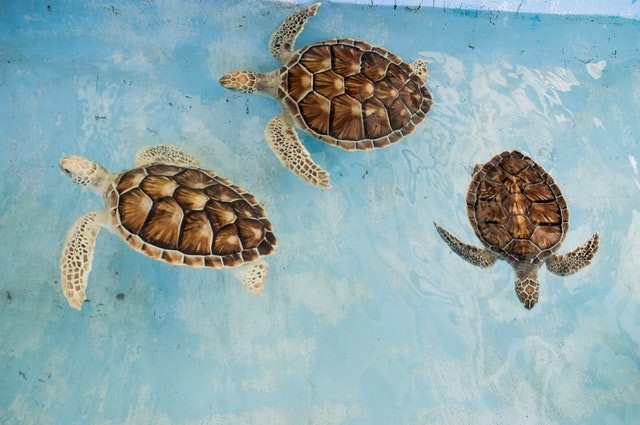Last week, adolescent turtles washed up on a beach located in Kalba, in which shriveled balloons and plastic foam are being cited as among the culprit for the demise of the creatures as they are reported to be the last things turtles ate.
As indicated in a Phys.org report, the hawksbill sea turtle lay belly-up on the metal autopsy table, "its shell ashen" and stomach stiff.
Once untouched, the mangrove trees' coast is fouled by trash piles dragged from landfills nearby. Strewn through the shore are bottle caps, packages, plastic bags, and far too frequently dead turtles.
Initially, marine expert Fadi Yaghmour examined some 200 turtles for the first study on the Middle East removed common fare from the carcass, oysters, and squid beaks.
READ ALSO: New Baby White Rhino Born at Disney's Animal Kingdom Theme Park

When thrown away, plastic is clogging waterways and choking animals, not only sea turtles but birds, whales, and all kinds of life, as well.
'Malnourished' Creature
Yagmhour explained perhaps the creature "is malnourished." He elaborated that plastic is clogging the intestinal tracts of turtles and can lead them to starve.
According to an ABC News report, this turtle is among the more than 60 recovered from shores of Kalba and Khor Fakkan in Sharjah's wider emirate, to be examined in the lab of Yaghmour.
His research team has published a new study in the Marine Pollution Bulletin that seeks to record the danger and damage of the throwaway plastic that has surged in use globally in the UAE, along with other marine debris.
When thrown away, plastic is clogging waterways and choking animals, not only sea turtles but birds, whales, and all kinds of life, as well.
Marine Debris Eaten
The study found that an astounding 75 percent of all green turtles and 57 percent of all loggerhead turtles in Sharjah had eaten marine debris, including bottle caps, rope and fishing nets, and plastic bags.
The only study from the region published in 1985 discovered that none of the examined turtles in the Gulf of Oman had eaten plastic.
According to Yaghmour, when the majority of sea turtles have plastics in their bodies, one would know there is a significant problem. He added that if ever there is a time to care about the turtle, "it is now."
The marine expert also explained when the turtles may have survived the mass extinction that wiped out dinosaurs millions of years ago, although today, they are vanishing all over the world.
Endangered Species
A Journal Review report said that according to The World Conversation Union had said that Hawksbill are crucially endangered, and green and loggerhead species are also endangered.
The three species are discovered in the warm, shallow waters of the Persian Gulf and the Gulf of Oman on the other side of the Strait of Hormuz.
Amounts of litter that rises steeply pollute the world's environment, with seminal research in Science Advances five years back approximating that 12 million metric tons will pile up by 2050.
Which Species Ate the Most Plastic?
A huge amount of debris was discovered inside the dead turtles in Sharjah. Specifically, more than 320 shards were found in one turtle and more than 30 pieces of fishing net in another. As a result, they can lead to deadly blockages, gas, and lacerations build up in the digestive tracts.
The study showed, too, that green sea turtles mostly tended to eat drifting plastic bags and ropes similar to their diet of jellyfish and cuttlefish.
On the other hand, Loggerheads were found to have eaten bottle caps and other tiny pieces of hard plastic mistaken for their appetizing snails and other marine invertebrates. Essentially, the youngest sea turtles were eaten the most plastic.
Related information about turtles dying from eating plastics is shown on WPTV News's YouTube video below:
RELATED ARTICLE: Endangered Seals Recieve Government Protection and Funding Until 2025
Check out more news and information on Endangered Species in Science Times














